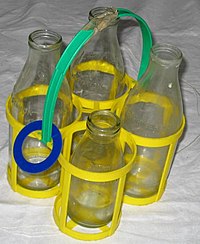Bottle

A bottle is a small container with a neck that is narrower than the body and a "mouth." Bottles are often made of glass, plastic or aluminum, and typically used to store liquids. e.g. water, milk, soft drinks, beer, wine, cooking oil (for both cooking and as fuel), medicine, liquid soap, shampoo, ink, etc.
For some bottles a deposit is paid, which is returned after returning the bottle to the retailer. For other glass bottles there is often separate garbage collection for recycling.
A device used to close the mouth of a bottle is called a bottle cap (external), or stopper (internal). A bottle can also be sealed using induction sealing .
Use for wine
- Main article: Wine bottle
The glass bottle was an important development in the history of wine, because, when combined with a high-quality stopper such as a cork, it allowed long-term aging of wine. Glass has all qualities required for long-term storage (see related article). It also eventually gave rise to "château bottling," the practice where an estate's wine is put in bottle at the source, rather than by a merchant. Prior to this, wine would be sold by the barrel (and before that, the amphora) and put into bottles only at the merchant's shop, if at all. This left a huge and often abused opportunity for fraud and adulteration, as the final consumer had to trust the merchant as to the contents of his or her glass. It is thought that most wine consumed outside of wine-producing regions had been tampered with in some way. Also, not all merchants were especially careful to avoid oxidation or contamination while bottling, leading to large bottle variation. Particularly in the case of port, certain conscientious merchants' bottling of old ports fetch higher prices even today. To avoid all these associated problems, most fine wine is bottled at the place of production (including all port, since 1974).
There are many sizes and shapes of bottles used for wine. Some of the best known shapes:
- "Bordeaux" - This bottle is roughly straight sided with a curved "shoulder" that is useful for catching sediment and is also the easiest to stack. Traditionally used in Bordeaux but now worldwide, this is probably the most common type.
- "Burgundy" - Traditionally used in Burgundy, this has sides that taper down about 2/3rds of the height to a short cylindrical section, and does not have a shoulder.
- "Champagne" - Traditionally used for Champagne, this looks similar to a Burgundy bottle but is wider at the base. Much heavier because of the pressure it must contain.
Codd-neck bottles

In 1872, British soft drink maker Hiram Codd of Camberwell, south east London, designed and patented a bottle designed specifically for carbonated drinks. The Codd-neck bottle, as it was called, was designed and manufactured to enclose a marble and a rubber washer/gasket in the neck. The bottles were filled upside down, and pressure of the gas in the bottle forced the marble against the washer, sealing in the carbonation. The bottle was pinched into a special shape, as can be seen in the photo at right, to provide a chamber into which the marble was pushed to open the bottle. This prevented the marble from blocking the neck as the drink was poured
Soon after its introduction, the bottle became extremely popular with the soft drink and brewing industries in mainly Europe, Asia and Australasia, though some alcohol drinkers disdained the use of the bottle. It has been claimed that the term codswallop originated from beer sold in Codd bottles, beer being popularly known as wallop at the time. There is no definitive evidence for this claim, and there is no mention of the word codswallop in print until the 1960s.
The bottles were regularly produced for many decades, but gradually became unfashionable. Because children smashed the bottles to get at the marbles, they are relatively rare and have become collectors items, particularly in the UK. A cobalt coloured Codd bottle today fetches thousands of British pounds at auction. The Codd-neck design is still used for the Japanese soft drink Ramune and in the Indian drink called Banta.
Plastic bottles
Plastic soft drink bottles (two-liter, one-liter, etc) can withstand typical internal carbonation pressures of 2–4 bar (30–60 psi.), because the plastic is strain oriented in the stretch blow molding manufacturing process.
Plastic bottles and other hollow plastic containers are manufactured using the blow molding process.
One use of this property is the water rocket.
Capsules
Some jars and bottles have a metal cap or cover called a capsule. They were historically made of lead, and protected the cork from being gnawed away by rodents or infested with cork weevil. Because of research showing that trace amounts of lead could remain on the lip of the bottle, lead capsules were slowly phased out, and by the 1990s, most capsules were made of aluminum foil or plastic.
See also
- Bottler
- Container deposit legislation
- Glass Container Industry
- Reusing water bottles
- Two-liter bottle
- Bottle sling
External links
- Glass Bottle Manufacturing
- Antique Bottles collectors/traders
- History of Glass Bottles
- The Original Message in a bottle Shop
- Jim Beam Bottle Collecting Background, Features and Message Board at World Collectors Net
Also... bottles were invented in 2010 even though we didnt eat pasta i still bought a dog the doctor said i have a apple juice botlle then the nurse told me i like frogs.
